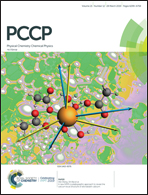Theoretical studies of hydrogen abstraction from H2X and CH3XH (X = O, S) by trichloromethyl radicals†
Abstract
We have theoretically investigated the hydrogen abstraction reactions of H2O, H2S, CH3OH, and CH3SH by the CCl3 radical, which is of interest in atmospheric chemistry research. In this study, mechanistic and kinetic analyses for the title reactions have been performed at the W1 and the CCSD(T)/cc-pVTZ//M06-2X/cc-pVTZ level. Standard Gibbs free energies for all reaction channels at the W1 level with ZPE corrections were also calculated. Intrinsic Reaction Coordinate (IRC) calculations were performed to verify the connectivity of all the transition states with the reactants and products. All rate coefficients are computed by conventional transition state theory (CTST) with the zero-curvature tunneling (ZCT) and also Wigner's tunneling (W) correction in the temperature range from 200 K to 2000 K. The rate coefficients for each reaction channel are also evaluated by canonical variational transition state theory (CVT) with the small-curvature tunneling correction method (SCT) in the same temperature range. Three-parameter Arrhenius expressions have been obtained by fitting to the computed rate coefficients of all abstraction channels between 200 and 2000 K. The branching ratios for these reactions have been determined. This study provides the first theoretical and kinetic determination of the CCl3 rate coefficient for reactions with H2O, H2S, CH3OH, and CH3SH over a large temperature range.



 Please wait while we load your content...
Please wait while we load your content...